Sustainable Perspectives Using Human Beings: The Sensory Properties of a Bio-Based Material Compared to a Synthetic Material—An Overall Assessment Based on an Innovative Blind Method
Abstract
1. Introduction
2. Materials and Methods
2.1. Creating the List of Descriptors
2.2. Panel Selection
2.3. Tactile Exploration of the Samples—Actual Proceedings
2.4. Blind Tests—Box Construction
2.5. The Steps of the Experiments
2.6. Result Analysis and Statistical Tools
3. Results
4. Conclusions
Funding
Institutional Review Board Statement
Informed Consent Statement
Data Availability Statement
Conflicts of Interest
References
- Thakur, M.; Sharma, C.; Mehta, A.; Torrico, D.D. Health claim effects on consumer acceptability, emotional responses, and purchase intent of protein bars. J. Agric. Food Res. 2022, 8, 100291. [Google Scholar] [CrossRef]
- Meiselman, H.L. The future in sensory/consumer research: Evolving to a better science. Food Qual. Prefer. 2013, 27, 208–214. [Google Scholar] [CrossRef]
- Foley, H.J.; Bates, M. Sensation and Perception, 6th ed.; Routledge: New York, NY, USA, 2019; p. 518. [Google Scholar] [CrossRef]
- Worch, T.; Lê, S.; Punter, P. How reliable are the consumers? Comparison of sensory profiles from consumers and experts. Food Qual. Prefer. 2010, 21, 309–318. [Google Scholar] [CrossRef]
- Gastón, A. Methodological challenges in sensory characterization. Curr. Opin. Food Sci. 2015, 3, 1–5. [Google Scholar] [CrossRef]
- Torrico, D.D.; Mehta, A.; Borssato, A.B. New methods to assess sensory responses: A brief review of innovative techniques in sensory evaluation. Curr. Opin. Food Sci. 2023, 49, 100978. [Google Scholar] [CrossRef]
- Torrico, D.D.; Jirangrat, W.; Wang, J.; Chompreeda, P.; Sriwattana, S.; Prinyawiwatkul, W. Novel Modelling Approaches to Characterize and Quantify Carryover Effects on Sensory Acceptability. Foods 2018, 7, 186. [Google Scholar] [CrossRef]
- Avramescu, A.-M. Approche de l’Impact des Matériaux Biosourcés sur la Qualité Perçue des Produits: Cas de la Fibre de lin, Engineering Sciences Pour l’Ingénieur. Doctoral Thesis, Université de Technologie de Belfort-Montbéliard, Montbéliard, France, 2013. [Google Scholar]
- Schlich, P. Uses of change-over designs and repeated measurements in sensory and consumer studies. Food Qual. Prefer. 1993, 4, 223–235. [Google Scholar] [CrossRef]
- Torrico, D.D.; Fuentes, S.; Viejo, C.G.; Ashman, H.; Dunshea, F.R. Cross-cultural effects of food product familiarity on sensory acceptability and non-invasive physiological responses of consumers. Food Res. Int. 2019, 115, 439–450. [Google Scholar] [CrossRef]
- Deliza, R.; MacFie, H.J. The generation of sensory expectation by external cues and its effect on sensory perception and hedonic ratings: A review. J. Sens. Stud. 1996, 11, 103–128. [Google Scholar] [CrossRef]
- Mead, R.; Gay, C. Sequential design of sensory trials. Food Qual. Prefer. 1995, 6, 271–280. [Google Scholar] [CrossRef]
- Yu, P.; Low, M.Y.; Zhou, W. Design of experiments and regression modelling in food flavour and sensory analysis: A review. Trends Food Sci. Technol. 2018, 71, 202–215. [Google Scholar] [CrossRef]
- Zoëga Ramsøy, T.; Michael, N.; Michael, I.A. Consumer Neuroscience Study of Conscious and Subconscious Destination Preference. Sci. Rep. 2019, 9, 15102. [Google Scholar] [CrossRef] [PubMed]
- Huseynov, S.; Kassas, B.; Segovia, M.S.; Palma, M.A. Incorporating biometric data in models of consumer choice. Appl. Econ. 2019, 51, 1514–1531. [Google Scholar] [CrossRef]
- Grewal, D.; Ailawadi, K.L.; Gauri, D.; Hall, K.; Kopalle, P.; Robertson, J.R. Innovations in retail pricing and promotions. J. Retail. 2011, 87, 43–52. [Google Scholar] [CrossRef]
- Ares, G.; Piqueras-Fiszman, B.; Varela, P.; Marco, R.M.; López, A.M.; Fiszman, S. Food labels: Do consumers perceive what semiotics want to convey? Food Qual. Prefer. 2011, 22, 689–698. [Google Scholar] [CrossRef]
- Jiang, R.; Sharma, C.; Bryant, R.; Mohan, M.S.; Al-Marashdeh, O.; Harrison, R.; Torrico, D.D. Animal welfare information affects consumers’ hedonic and emotional responses towards milk. Food Res. Int. 2021, 141, 110006. [Google Scholar] [CrossRef]
- Hsu, M.; Yoon, C. The neuroscience of consumer choice. Curr. Opin. Behav. Sci. 2015, 5, 116–121. [Google Scholar] [CrossRef]
- Bell, L.; Vogt, J.; Willemse, C.; Routledge, T.; Butler, L.T.; Sakaki, M. Beyond self-report: A review of physiological and neuroscientific methods to investigate consumer behavior. Front. Psychol. 2018, 9, 1655. [Google Scholar] [CrossRef]
- Karmarkar, U.R.; Yoon, C. Consumer neuroscience: Advances in understanding consumer psychology. Curr. Opin. Psychol. 2016, 10, 160–165. [Google Scholar] [CrossRef]
- Shaw, S.D.; Bagozzi, R.P. The neuropsychology of consumer behavior and marketing. Consum. Psychol. Rev. 2018, 1, 22–40. [Google Scholar] [CrossRef]
- Kirwan, B.C.; Vance, A.; Jenkins, J.L.; Anderson, B.B. Embracing brain and behaviour: Designing programs of complementary neurophysiological and behavioural studies. Inf. Syst. J. 2022, 33, 324–349. [Google Scholar] [CrossRef]
- Berman, G. Measuring behavior across scales. BMC Biol. 2018, 16, 23. [Google Scholar] [CrossRef] [PubMed]
- Boccia, M.; Nemmi, F.; Guariglia, C. Neuropsychology of Environmental Navigation in Humans: Review and Meta-Analysis of fMRI Studies in Healthy Participants. Neuropsychol. Rev. 2014, 24, 236–251. [Google Scholar] [CrossRef] [PubMed]
- Ioanid, A.; Scarlat, C. Neuromarketing Tools in Industry 4.0 Context: A Study on the Romanian Market. In Proceedings of the 15th International Conference Interdisciplinarity in Engineering, Târgu Mureș, Romania, 7–8 October 2021; Volume 386, pp. 370–381. [Google Scholar] [CrossRef]
- Jung, H.Y.; Kwak, H.S.; Kim, M.J.; Kim, Y.; Kim, K.O.; Kim, S.S. Comparison of a descriptive analysis and instrumental measurements (electronic nose and electronic tongue) for the sensory profiling of Korean fermented soybean paste (Doenjang). J Sens. Stud. 2017, 32, e12282. [Google Scholar] [CrossRef]
- Reddy, M.M.; Vivekanandhan, S.; Misra, M.; Bhatia, S.K.; Mohanty, A.K. Biobased plastics and bionanocomposites: Current status and future opportunities. Prog. Polym. Sci. 2013, 38, 1653–1689. [Google Scholar] [CrossRef]
- Blasco-Arcas, L.; Meg Lee, H.H.; Kastanakis, M.N.; Alcañiz, M.; Reyes-Menendez, A. The role of consumer data in marketing: A research agenda. J. Bus. Res. 2022, 146, 436–452. [Google Scholar] [CrossRef]
- Pantilimon, M.C.; Berbecaru, A.; Ciuca, S.; Sohaciu, M.; Reumont, G.; Coman, G.; Predescu, C. Transformation Induced Plasticity Steels Used in Automotive Industry. Univ. Politeh. Buchar. Sci. Bull. Ser. B-Chem. Mater. Sci. 2019, 81, 273–280. [Google Scholar]
- Dobre, C.; Grosu, L.; Dobrovicescu, A.; Chișiu, G.; Constantin, M. Stirling Refrigerating Machine Modeling Using Schmidt and Finite Physical Dimensions Thermodynamic Models: A Comparison with Experiments. Entropy 2021, 23, 368. [Google Scholar] [CrossRef]
- Knutson, B.; Rick, S.; Wimmer, G.E.; Prelec, D.; Loewenstein, G. Neural Predictors of Purchases. Neuron 2007, 53, 147–156. [Google Scholar] [CrossRef]
- Ravaja, N.; Somervuori, O.; Salminen, M. Predicting purchase decision: The role of hemispheric asymmetry over the frontal cortex. J. Neurosci. Psychol. Econ. 2013, 6, 1–13. [Google Scholar] [CrossRef]
- Li, Y.; Liang, J.; Huang, J.; Yang, M.; Li, R. Behavioral Research in Construction Engineering Management: A Review from a Neuropsychological Perspective. Buildings 2022, 12, 1591. [Google Scholar] [CrossRef]
- Karmarkar, U.R.; Plassmann, H. Consumer Neuroscience: Past, Present, and Future. Organ. Res. Methods 2019, 22, 174–195. [Google Scholar] [CrossRef]
- Duflou, J.R.; Yelin, D.; Van Acker, K.; Dewulf, W. Comparative impact assessment for flax fibre versus conventional glass fibre reinforced composites: Are bio-based reinforcement materials the way to go? CIRP Ann. 2014, 63, 45–48. [Google Scholar] [CrossRef]
- Amiri, A.; Yu, A.; Webster, D.; Ulven, C. Bio-Based Resin Reinforced with Flax Fiber as Thermorheologically Complex Materials. Polymers 2016, 8, 153. [Google Scholar] [CrossRef]
- Cuinat-Guerraz, N.; Dumont, M.J.; Hubert, P. Environmental resistance of flax/bio-based epoxy and flax/polyurethane composites manufactured by resin transfer moulding, Composites Part A. Appl. Sci. Manuf. 2016, 88, 140–147. [Google Scholar] [CrossRef]
- Musa, C.; Kervoëlen, A.; Danjou, P.E.; Bourmaud, A.; Delattre, F. Bio-based unidirectional composite made of flax fibre and isosorbide-based epoxy resin. Mater. Lett. 2020, 258, 126818. [Google Scholar] [CrossRef]
- Cadu, T.; Berges, M.; Sicot, O.; Person, V.; Piezel, B.; Van Schoors, L.; Placet, V.; Corn, S.; Léger, R.; Divet, L.; et al. What are the key parameters to produce a high-grade bio-based composite? Application to flax/epoxy UD laminates produced by thermocompression. Compos. Part B Eng. 2018, 150, 36–46. [Google Scholar] [CrossRef]
- Essid, S.; Jayaprakash Hegde, V.; Mahieu, A.; Bizet, L.; Leblanc, N.; Saouab, A. Comparison of the properties of flax shives based particleboards prepared using binders of bio-based lignin and partially bio-based epoxy resin. Int. J. Adhes. Adhes. 2021, 109, 102915. [Google Scholar] [CrossRef]
- Taylor, C.; Amiri, A.; Paramarta, A.; Ulven, C.; Webster, D. Development and weatherability of bio-based composites of structural quality using flax fiber and epoxidized sucrose soyate. Mater. Des. 2017, 113, 17–26. [Google Scholar] [CrossRef]
- Hosseini, N.; Ulven, C.A.; Azarmi, F.; Webster, D.C.; Nelson, T.J. Utilization of Flax Fibers and Glass Fibers in a Bio-Based Resin. In Proceedings of the ASME 2014 International Mechanical Engineering Congress and Exposition, Montreal, QU, Canada, 14–20 November 2014; Volume 14. [Google Scholar] [CrossRef]
- Pandit, P.; Nadathur, G.T.; Maiti, S.; Regubalan, B. Functionality and Properties of Bio-based Materials. In Bio-Based Materials for Food Packaging; Springer: Singapore, 2018; pp. 81–103. [Google Scholar] [CrossRef]
- Benmahiddine, F.; Cherif, R.; Bennai, F.; Belarbi, R.; Tahakourt, A.; Abahri, K. Effect of flax shives content and size on the hygrothermal and mechanical properties of flax concrete. Constr. Build. Mater. 2020, 262, 120077. [Google Scholar] [CrossRef]
- Sorrentino, L.; Turchetta, S.; Parodo, G.; Papa, R.; Toto, E.; Santonicola, M.G.; Laurenzi, S. RIFT Process Analysis for the Production of Green Composites in Flax Fibers and Bio-Based Epoxy Resin. Materials 2022, 15, 8173. [Google Scholar] [CrossRef] [PubMed]
- Page, J.; Sonebi, M.; Amziane, S. Design and multi-physical properties of a new hybrid hemp-flax composite material. Constr. Build. Mater. 2017, 139, 502–512. [Google Scholar] [CrossRef]
- Jones, D.; Brischke, C. Performance of Bio-Based Building Materials; Woodhead Publishing: Cambridge, UK, 2017; p. 650. [Google Scholar]
- Avramescu, A.-M.; Bazzaro, F.; Mahdjoub, M.; Sagot, J.-C.; Simion, I. Elaboration d’une démarche pour l’analyse sensorielle tactile des matériaux bio-sourcés. UPB Sci. Bull. Series B 2014, 76, 235–246. [Google Scholar]
- Avramescu, A. The Importance and Necessity of New Bio-Based Materials in Industrial Design. Mater. Plast. 2023, 60, 121–127. [Google Scholar] [CrossRef]
- Avramescu, A.-M. Etude prospective sur l’exploitation des materiaux naturels compares aux materiaux synthetiques. UPB Sci. Bull. Series B 2023, 85, 235–247. [Google Scholar]
- Lhéritier, A.-M. Intégration sensorielle et sociétale dans la conception produit. In Levier d’Innovation dans le Secteur des Bio-Industries. Mémoire HDR (Mémoire d’habilitation a Diriger des Recherches); Université de Grenoble: Paris, France, 2013; p. 136. [Google Scholar]
- Nicolae, A.; Sohaciu, M.G.; Csáki, I.; Ciucă, S.; Nicolae, M.; Dumitrescu, R.E. Information about the engineering of sustainable and durable materials (ESDM). UPB Sci. Bull. Ser. B Chem. Mater. Sci. 2020, 82, 211–220. [Google Scholar]
- Hildebrandt, J.; Thrän, D.; Bezama, D. The circularity of potential bio-textile production routes: Comparing life cycle impacts of bio-based materials used within the manufacturing of selected leather substitutes. J. Clean. Prod. 2021, 287, 125470. [Google Scholar] [CrossRef]
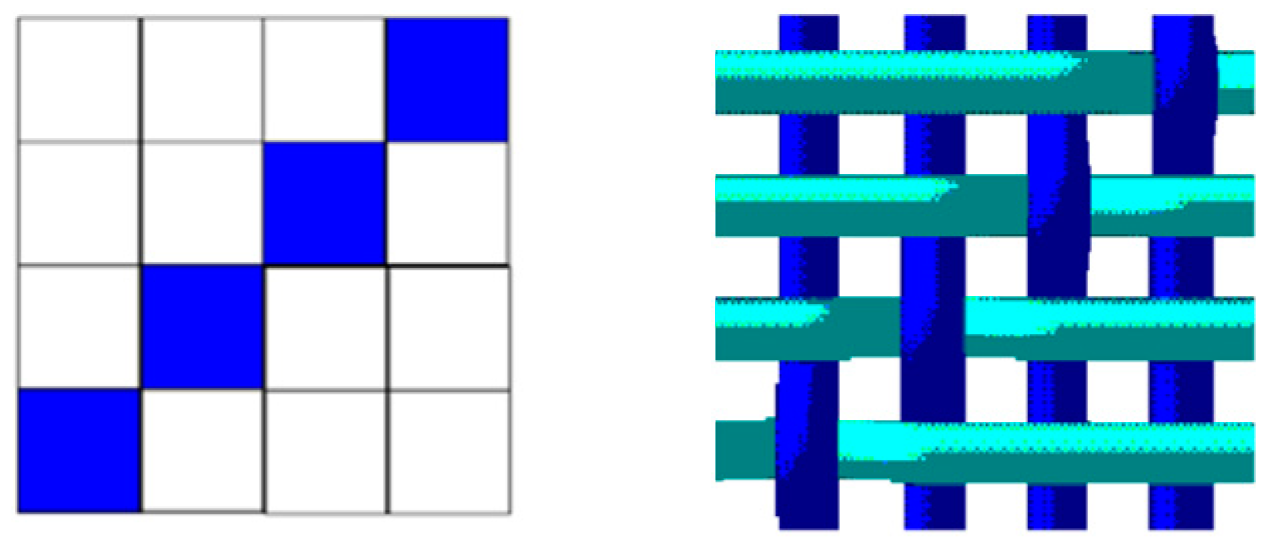
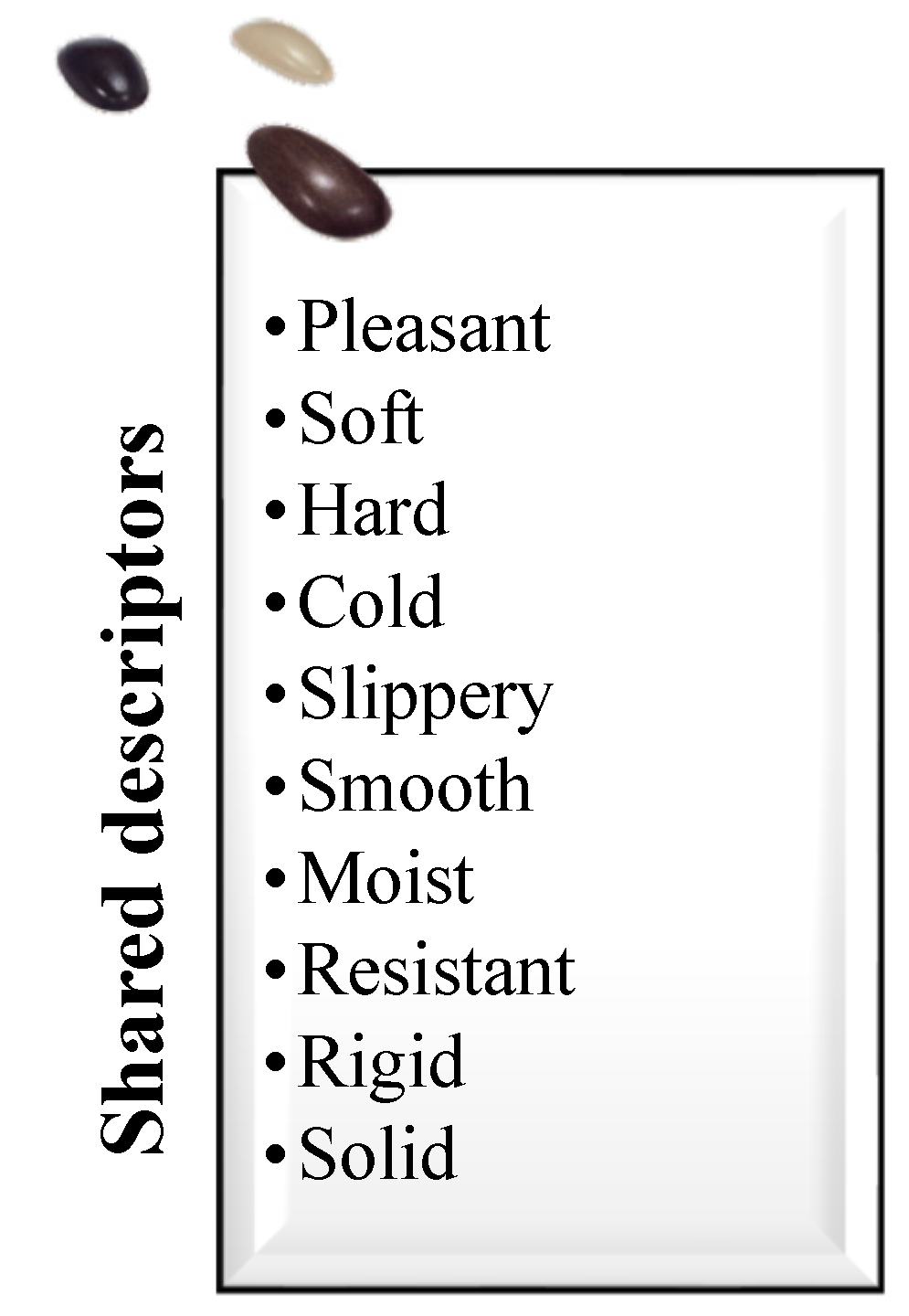


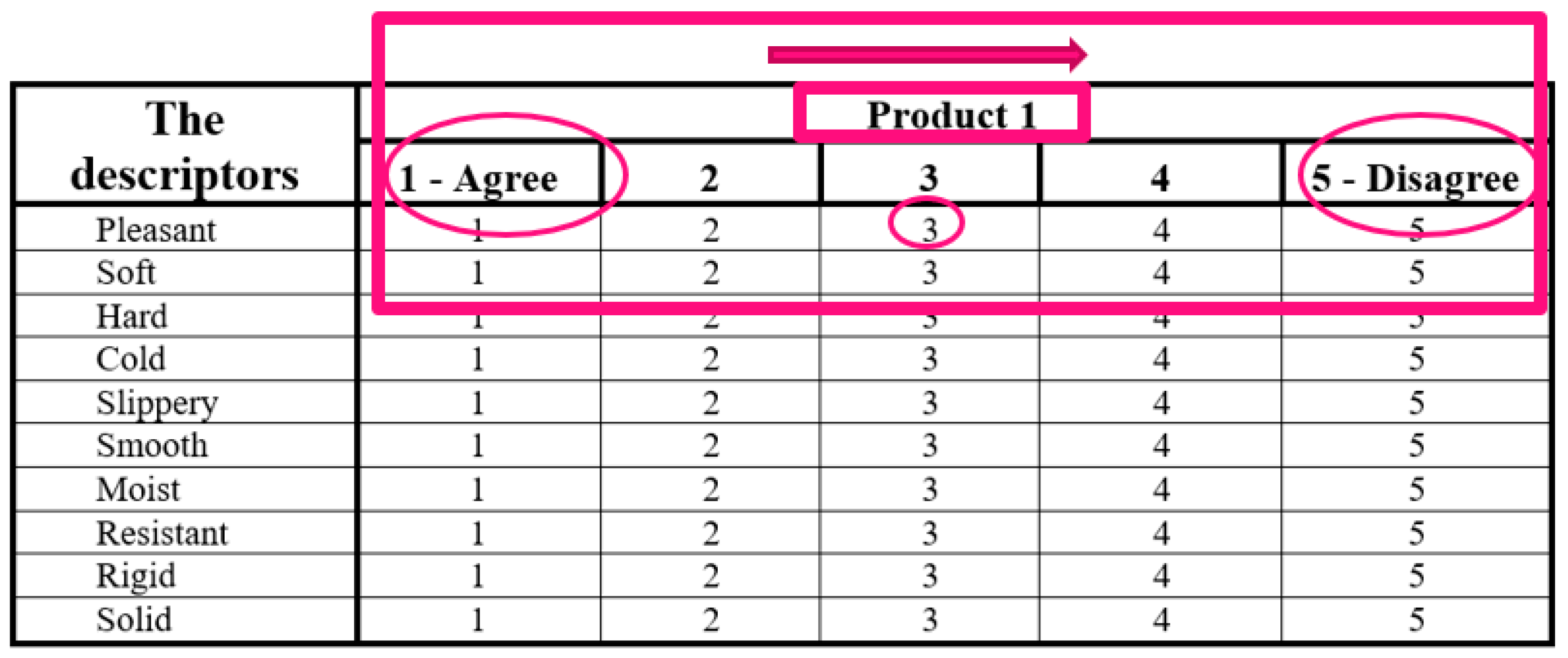
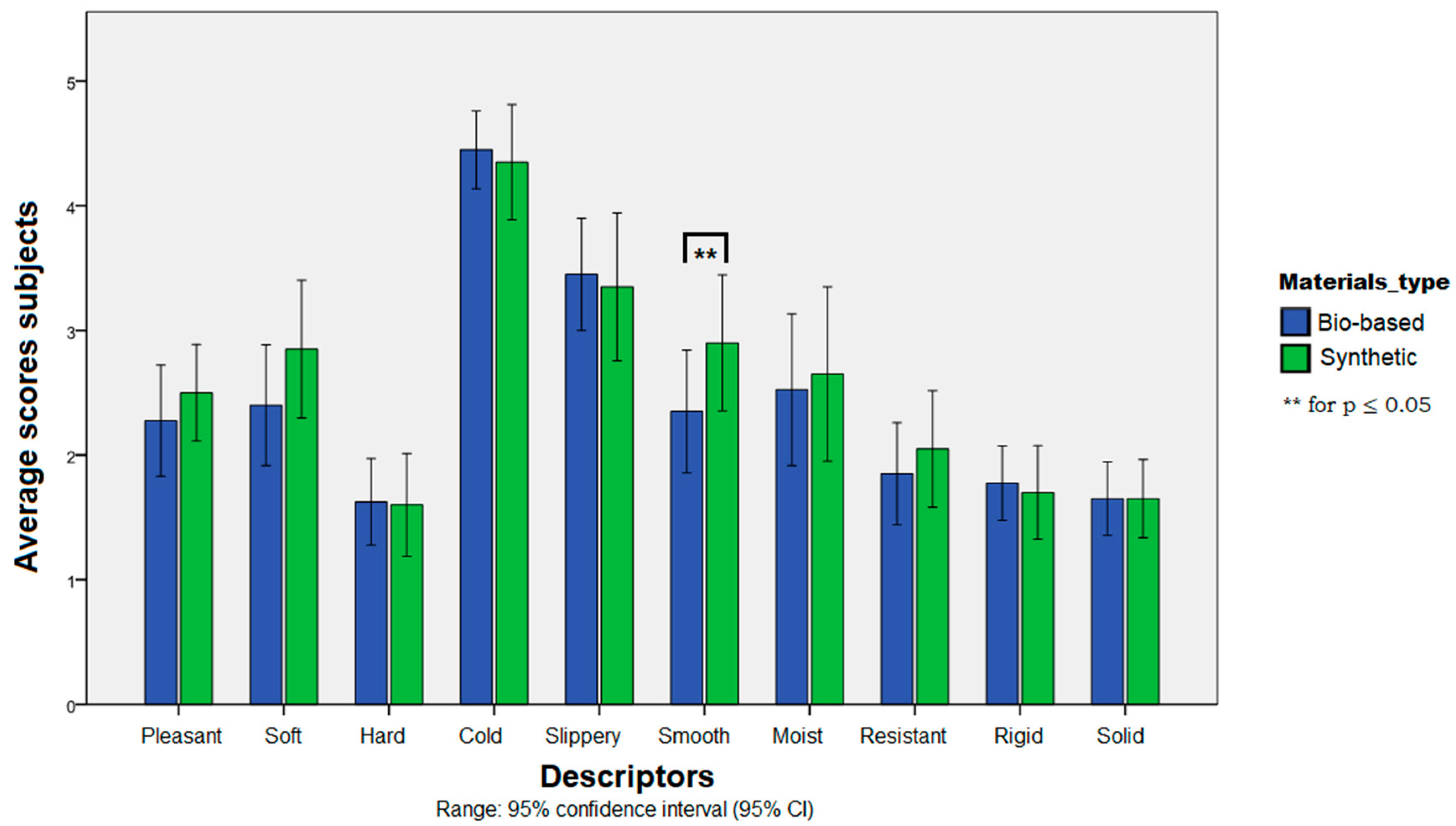
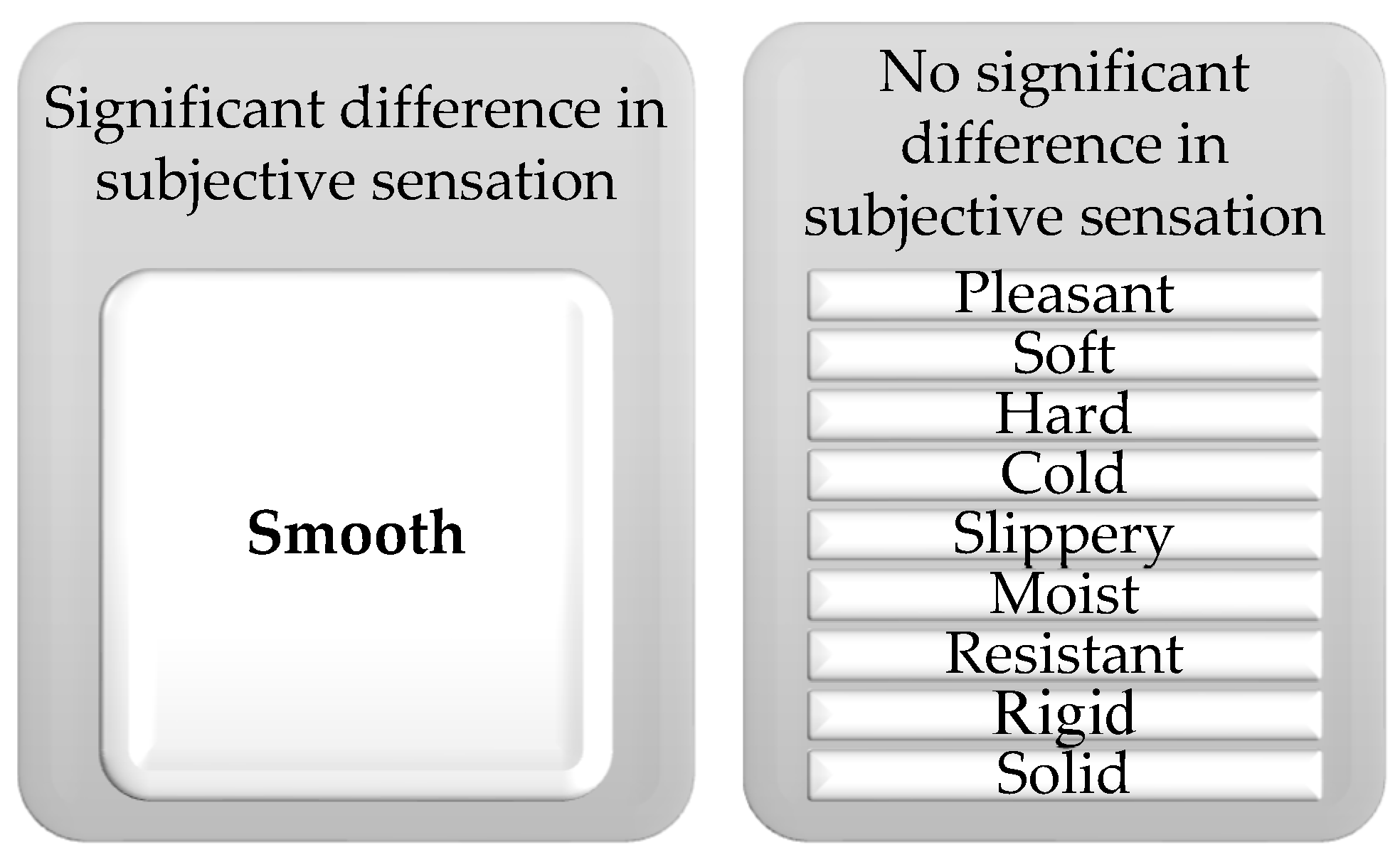
| Type of Fabric | Surface Variation | Identical Products | Abbreviations | Product |
|---|---|---|---|---|
| Twill bio-based material | 1 | 1 | Product-1 |  |
| Unidirectional bio-based material | 1 | 1 | Product-2 |  |
| Synthetic fiberglass material | 1 | 1 | Product-3 |  |
| Results Bio-Based vs. Synthetic Materials | ||||||
|---|---|---|---|---|---|---|
| Descriptors | Material | Mean | Standard Error | t | ddl | p |
| Pleasant | Bio-based | 2.23 | 0.18 | −1.26 | 19 | ≥0.05 |
| Fiberglass | 2.50 | 0.19 | ||||
| Soft | Bio-based | 2.40 | 0.23 | −1.71 | 19 | ≥0.05 |
| Fiberglass | 2.85 | 0.26 | ||||
| Hard | Bio-based | 1.63 | 0.17 | 0.15 | 19 | ≥0.05 |
| Fiberglass | 1.60 | 0.20 | ||||
| Cold | Bio-based | 4.45 | 0.15 | 0.72 | 19 | ≥0.05 |
| Fiberglass | 4.35 | 0.22 | ||||
| Slippery | Bio-based | 3.45 | 0.21 | 0.43 | 19 | ≥0.05 |
| Fiberglass | 3.35 | 0.28 | ||||
| Smooth | Bio-based | 2.35 | 0.24 | −3.32 | 19 | ≤0.05 |
| Fiberglass | 2.90 | 0.26 | ||||
| Moist | Bio-based | 2.53 | 0.30 | −0.46 | 19 | ≥0.05 |
| Fiberglass | 2.65 | 0.33 | ||||
| Resistant | Bio-based | 1.85 | 0.20 | −0.97 | 19 | ≥0.05 |
| Fiberglass | 2.05 | 0. 22 | ||||
| Rigid | Bio-based | 1.78 | 0.14 | 0.77 | 19 | ≥0.05 |
| Fiberglass | 1.70 | 0. 18 | ||||
| Solid | Bio-based | 1.65 | 0.14 | 0.00 | 19 | ≥0.05 |
| Fiberglass | 1.65 | 0.15 | ||||
| Results Twill Bio-Based Material vs. Synthetic Fiberglass Material | ||||||
|---|---|---|---|---|---|---|
| Descriptors | Material | Mean | Standard Error | t | ddl | p |
| Smooth | Twill | 2.30 | 0.30 | −2.26 | 19 | ≤0.05 |
| Fiberglass | 2.90 | 0.26 | ||||
| Results Unidirectional Bio-Based Material vs. Synthetic Fiberglass Material | ||||||
|---|---|---|---|---|---|---|
| Descriptors | Material | Mean | Standard Error | t | ddl | p |
| Smooth | Unidirectional | 2.40 | 0.26 | −2.26 | 19 | ≤0.05 |
| Fiberglass | 2.90 | 0.26 | ||||
Disclaimer/Publisher’s Note: The statements, opinions and data contained in all publications are solely those of the individual author(s) and contributor(s) and not of MDPI and/or the editor(s). MDPI and/or the editor(s) disclaim responsibility for any injury to people or property resulting from any ideas, methods, instructions or products referred to in the content. |
© 2023 by the author. Licensee MDPI, Basel, Switzerland. This article is an open access article distributed under the terms and conditions of the Creative Commons Attribution (CC BY) license (https://creativecommons.org/licenses/by/4.0/).
Share and Cite
Nicolau, A.-M. Sustainable Perspectives Using Human Beings: The Sensory Properties of a Bio-Based Material Compared to a Synthetic Material—An Overall Assessment Based on an Innovative Blind Method. Sustainability 2023, 15, 9145. https://doi.org/10.3390/su15129145
Nicolau A-M. Sustainable Perspectives Using Human Beings: The Sensory Properties of a Bio-Based Material Compared to a Synthetic Material—An Overall Assessment Based on an Innovative Blind Method. Sustainability. 2023; 15(12):9145. https://doi.org/10.3390/su15129145
Chicago/Turabian StyleNicolau, Ana-Maria. 2023. "Sustainable Perspectives Using Human Beings: The Sensory Properties of a Bio-Based Material Compared to a Synthetic Material—An Overall Assessment Based on an Innovative Blind Method" Sustainability 15, no. 12: 9145. https://doi.org/10.3390/su15129145
APA StyleNicolau, A.-M. (2023). Sustainable Perspectives Using Human Beings: The Sensory Properties of a Bio-Based Material Compared to a Synthetic Material—An Overall Assessment Based on an Innovative Blind Method. Sustainability, 15(12), 9145. https://doi.org/10.3390/su15129145






